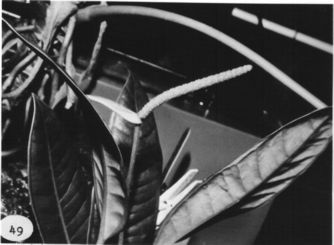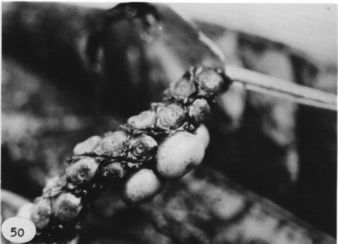





Anthurium crassitepalum Croat, sp. nov.
TYPE: Panama. Darien: Serrania de Pirre, along headwaters of Río Escucho Ruido, ca. 16 km due N ofAlturas de Nique, lower montane rain forest, 1,530-1,550 m, Croat 37948 (MO 2416720, holotype; PMA, isotype; Live at MO).
Planta epiphytica; cataphyllum modice membranaceum, basi findens, apice persistens plus minusve intactum; petiolus sulcatus, (5-)8-20(-28) cm longus; lamina subcoriacea, oblongo-elliptica ad anguste elliptica, basi acuta aut attenuala, 6.5-27 cm longa, 3-7 cm lata, pagina superiorc obscure glanduloso-punctata, pagina inferiore dense glanduloso punctata; inflorescentia effusa; pedunculus 13-29 cm longus, teres aut obscure 3-4 costatus; spatha modice rnembranacea, pallide viridis, interdum suffusa rubens, lanceolata ad ovata, 1.8-3.2 cm longa, 0.5-1.2 cm lata; spadix pallide viridis, 3-6.5 cm long; tepala margines externes conspicue elevata; baccae pallide lavandulae ad albidae, depres-so-globosae, 5-6 mm longae.
Epiphyte; stems usually less than 10 cm long, ca. 1 cm diam.; roots thin, green, descending; cataphylls moderately thin, 3-3.5 cm long, rounded at apex, drying medium brown, splitting at base, the apex remaining more or less intact.
LEAVES erect-spreading; petioles (5-)8-20(-28) cm long, 3-5 mm diam., sulcate, the margins sharp; geniculum 1.7-2.5 cm long; blades medium thick, oblong-elliptic to narrowly elliptic, short to gradually acuminate at apex, acute to attenuate at base, 6.5-27 cm long, 3-7 cm wide, broadest at middle or slightly below; upper surface matte to semiglossy, obscurely glandular-punctate (drying blackish green or dark brown), lower surface semiglossy, paler, densely dark, glandular-punctate (drying brownish); midrib convexly raised above, becoming more acute, then diminishing and sunken at apex; convexly raised below; primary lateral veins 6-10 per side, departing midrib at ca. 60°, sunken in valleys above, raised below, more or less straight to collective vein; interprimary veins obscure above and below; collective vein arising from the base sunken above, raised below, 1-5 mm from margin.
INFLORESCENCE spreading; peduncle 13-29 cm long; ca. 3 mm diam., sometimes faintly tinged reddish, terete or obscurely 3-4-ribbed, 2-5 times longer than petioles; spathe moderately thin, pale green, sometimes tinged reddish, lanceolate to ovate, 1.8-3.2 cm long, 0.5-1.2 cm wide, broadest at the base, acuminate at apex, rounded to obtuse at base, inserted at 45° angle on peduncle; spadix pale green (B & K Yellow-green 7/10), scarcely tapered, 3-6.5 cm long, 4÷ 5 mm near base, 2.5-3.5 mm diam. near apex; flower rhombic to 4-lobed, 3-4 mm in both directions, the sides more or less straight, 2-3 flowers visible in the principal spiral, 4÷5 visible in alternate spiral; tepals semiglossy, minutely papillate, the outer margins conspicuously raised giving spadix a cobbled texture; lateral tepals ca. 1.5 mm wide, the inner margin more or less straight; pistils raised, green; stigmas ellipsoid, 0.4-0.5 mm long, green, brush-like, exserted; stamens emerging from the base in a regular sequence, one or both lateral stamens exposed before alternates emerge, briefly exposed then retracted, faintly visible below surface of tepals; anthers pale yellow; pollen cream.
INFRUCTESCENCE with berries pale lavender to whitish, depressed-globose, 5-6 mm long, 10-11 mm wide; seeds 4, ovoid, greenish, 2.3-2.5 mm long, 1.1-1.7 mm wide, 1-1.3 mm thick (possibly immature). Figs. 49 and 50.
Anthurium crassitepalum is endemic to Panama in the Serrania de Pirre of Darien Province from 1,100 to 1,600 m in premontane and lower montane rain forest.
The species is a member of section Porphyrochitonium and is distinguished by its oblong-elliptic, glandular-punctate, gradually acuminate leaves, which are acute to attenuate at the base with sunken primary lateral and collective veins and especially by its greenish yellow spadix with the tepals being much thickened and slightly turned up along their outer margins giving the surface a texture comparable to a cobblestone street. The name crassitepalum refers to the thickened tepals.
The species is most easily confused with smaller leaved plants of Anthurium pirrense with which it occurs; this confusion arises because the two species have petioles and leaf shapes that are similar and the leaves of both dry blackish green to dark brown on the upper surface and brownish beneath. Anthurium pirrense usually has much larger, more coriaceous blades that dry with a prominently raised collective vein, whereas . A crassitepalum has the collective drying flat. Anthurium pirrense also diners in having a much longer, relatively more slender spadix that soon turns orange-brown and has a purplish ring around the pistil owing to the coloration of the inner margin of the tepals. Anthurium crassitepalum also has leaves similar to those of A. pageanum; the latter species. however, has primary lateral veins more deeply sunken, a petiole that is sharply triangular with sharply erect margins (rounded abaxially with inconspicuous margins on A. crassitepalum) and especially a comparatively smoother spadix with tepals not markedly thickened or turned up marginally. Because of their small size. two other species in section Porphyrochitonium, A. terryae and A. tacarcunense, can be confused with A. crassitepalum. Both are distinguished by having leaf blades usually broadest above the middle and by having the flowers dry semiintact (e.g.. tepals not greatly distorted).
 |
 |
Darien: Cerro Pirre. Folsom et Mauseth 8576 (MO):